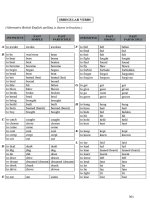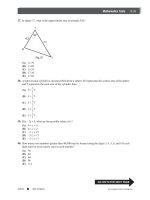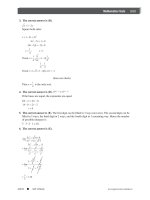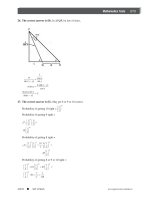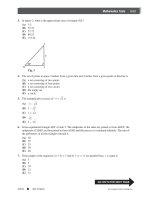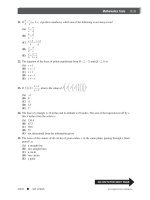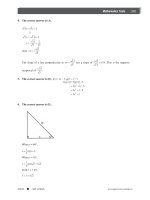SAT II Biology Episode 2 Part 5 ppt
Bạn đang xem bản rút gọn của tài liệu. Xem và tải ngay bản đầy đủ của tài liệu tại đây (153.47 KB, 20 trang )
77. The correct answer is (E). Primary consumers do not photo-
synthesize (only producers carry out photosynthesis). Excretion
provides some metabolic waste materials that can be utilized by
detritivores and, thus, are not lost from the ecosystem. Energy
that goes into the metabolism and growth of an organism
contributes to the biomass of the organism and is subsequently
passed on to the next higher trophic level. The energy used in
respiration results in the production of inorganic molecules and
heat; it is largely lost from the flow of energy in the ecosystem.
78. The correct answer is (E). The heritability of variation is a key
component to the theory of natural selection and is necessary for
evolution to occur. Those individuals that are most adapted to
their environment are most likely to survive and successfully
reproduce, passing on favorable genes to their offspring. As long
as the selection forces remain in place, the number of individuals
in the population with favorable genes will continue to increase,
possibly leading to the development of a new species after many
generations.
79. The correct answer is (A).
80. The correct answer is (D).
BIOLOGY-M TEST
81. The correct answer is (C). In the DNA molecule, base pairing
occurs between adenine and thymine, which are held together
by two hydrogen bonds, and base pairing occurs between
guanine and cytosine, which are held together by three hydrogen
bonds.
82. The correct answer is (D). Under normal conditions of DNA
replication, telomeres that are present on the end of each
chromosome in eukaryotic cells become shorter and shorter with
each cycle of replication. The length of the telomeres typically
predetermines the life span of the cell by controlling the number
of possible cycles of DNA replication. Telomerase, an enzyme
that catalyzes the lengthening of telomeres, is not present in the
cells of most multicellular organisms other than those giving rise
to gametes. Telomerase has been found to occur in cells that
become cancerous, suggesting a possible link between “uncon-
trolled” cell division and the cancerous nature of the cell.
83. The correct answer is (B). The process of transcription takes
place in the nucleus of eukaryotic cells. The nucleotide sequence on
the DNA molecule is transcribed into an RNA replica (messenger
RNA, or mRNA). The mRNA transcript moves out of the nucleus
through pores in the nuclear envelope and attaches to a ribosome
ANSWERS AND EXPLANATIONS
257
Peterson’s n SAT II
Success: Biology E/M www.petersons.com
complex. The mRNA is then translated into a polypeptide chain
consisting of amino acids in the sequence that is coded for by the
sequence of base triplets on the mRNA molecule.
84. The correct answer is (D).
85. The correct answer is (B).
86. The correct answer is (E).
87. The correct answer is (D). First, one must isolate the bacterial
plasmid that is to be the cloning vector from its bacterial host
and isolate the region of DNA that contains the gene of interest
to be cloned from eukaryotic tissue cells. Next, both the plasmid
and the eukaryotic DNA are digested with the same restriction
enzyme, creating sticky ends. When the two cell types are mixed
together in the presence of DNA ligase, the plasmid DNA and
eukaryotic DNA may bind together (also, the eukaryotic DNA
may reassociate and the plasmid DNA may reassociate; thus, the
mixture will contain both recombinant molecules and molecules
like the originals). Bacteria that are bathed in a solution of the
naked DNA mixture will take up the plasmid vector by transfor-
mation. As the bacterial cells replicate, so, too, will any plasmids
that they contain. If the plasmid(s) are recombinant, the eukary-
otic gene of interest also will be replicated many times. Finally,
the eukaryotic gene insert can be detected using either nucleic
acid hybridization or a similar method.
88. The correct answer is (B). The union of the sticky ends of
eukaryotic DNA and plasmid DNA is similar to the formation of
the DNA double helix, relying on pairing between complemen-
tary bases (A with T; G with C).
89. The correct answer is (B). Each restriction enzyme recognizes
a specific sequence of bases (usually four to six nucleotides in
length), known as the restriction site (or target site), on a DNA
molecule; it does not cleave DNA at random sites.
90. The correct answer is (E). Transpiration, choice (A), is the loss
of water vapor by plants to the atmosphere. Electroporation,
choice (B), is the application of electrical impulses to animal
cells or plant protoplasts. This increases the permeability of their
membranes that aid the uptake of foreign DNA by transforma-
tion, choice (E), the uptake by cells of soluble fragments of
foreign DNA in solution. Translation, choice (C), is the process
by which the genetic information in living cells encoded in the
form of base triplets in mRNA is converted to a sequence of
amino acids in a polypeptide chain. Transduction, choice (D), is
the transfer of genetic material from one bacterial cell to another
using a phage as a vector.
PRACTICE TEST 1
258
Peterson’s n SAT II
Success: Biology E/Mwww.petersons.com
91. The correct answer is (E). Evidence from molecular genetic
studies suggests earlier evolutionary splits among prokaryotic
organisms and relatively simple eukaryotic organisms (primarily
those organisms classified as Protists in the five-kingdom system)
than was previously thought. Such evidence has led many
researchers to further subdivide these groups of organisms into
separate kingdoms, based on their ancient evolutionary lineages.
92. The correct answer is (B). Competition for a limited supply of
resources and a mechanism for passing on traits that confer an
advantage for adaptation to environmental conditions from parents
to offspring are necessary for evolution to occur at any level.
Protobionts (aggregates of abiotic molecules that maintain an inter-
nal environment that is different from their surroundings) could not
have evolved into early living cells (with semipermeable mem-
branes, the ability to reproduce, the ability to catalyze chemical
reactions, or any other characteristics typically associated with liv-
ing cells) without competition among individuals for limited
resources and the ability to pass favorable traits on to offspring.
93. The correct answer is (D). Cladistic analysis relies on homol-
ogy (similarity of characteristics among species due to a shared
ancestry) in the construction of phylogenetic trees while
avoiding analogous characters (similarity of characteristics among
species that are not closely related; these characteristics are
usually attributed to convergent evolution).
94. The correct answer is (D). Each triplet of bases on the mRNA
molecule (codon) codes for a specific amino acid. The code has
been deciphered and is represented in the table of genetic
codons, with the first base along the left side, the second base
across the top, and the third base along the right side of the
table. More than one codon may code for the same amino acid.
The codon AUG may code for methionine or it may code for a
start site, signaling ribosomes to begin translating the mRNA at
that site. Three “stop” codons (UAA, UAG, UGA), when present
within a genetic message, signal the end of the message and
termination of translation in that region.
95. The correct answer is (D). The substitution of an “A” for a “U”
in the third base position of the codon for Gly results in a codon
that also codes for Gly; thus, the resulting polypeptide should func-
tion normally. All of the other substitutions described above result
in the replacement of the ‘correct’ amino acid with an ‘incorrect’
amino acid in the polypeptide chain produced in translation. The
relative effects of such substitutions on an individual depend on the
degree to which the incorrect amino acid changes the function of
the polypeptide. For example, a single base substitution (U for A)
ANSWERS AND EXPLANATIONS
259
Peterson’s n SAT II
Success: Biology E/M www.petersons.com
results in the incorporation of Val in place of Glu in the sixth posi-
tion of the polypeptide coding for the primary structure of hemoglo-
bin, resulting in the abnormally shaped cells that are characteristic
of sickle cell anemia.
96. The correct answer is (B). Restriction enzymes recognize
specific base sequences along the DNA molecule (usually 4 to 6
bases long) and cleave the molecule at each of these sites. When
the fragments of DNA that are produced are separated electro-
phoretically, a characteristic pattern is produced. If two species
share a similar pattern, they must share a similar number of
restriction sites at equivalent distances along the DNA molecule.
This suggests that the genomes of the two species are similar and
that they most likely diverged in relatively recent history.
97. The correct answer is (A). In the figure, taxon Z represents
the outgroup—a species or group of species that is closely
related to the other taxa being studied, but not as closely related
as each of the study taxa are to each other. The position of taxon
Z on the phylogenetic tree suggests that it possesses the primi-
tive condition shared by all of the taxa depicted and from which
the other taxa have diverged.
98. The correct answer is (D). The change from a primitive to a
derived state of character I separates taxon Z (the outgroup)
from the remaining species. Taxa B, C, and D share two derived
characters and, thus, are more closely related to each other than
each is to taxon A. Following this reasoning, taxa C and D
appear to be the most closely related pair of taxa depicted.
These two taxa share three derived characters (I, II, and III),
suggesting that they are more closely related to each other than
either is to taxon B.
99. The correct answer is (E). The results suggest that species C
shares genetic information with species A as well as with species
B, whereas species A and B are genetically distinct from one
another. The most likely explanation is that species C inherited
genetic material from both species A and B, suggesting that it is a
hybrid between the two.
100. The correct answer is (A). Some scientists suggest that the
earth’s surface was inhospitable during the period in which life
began. Recent molecular studies suggest that the ancestors of
modern-day prokaryotes thrived in very hot conditions and
possibly utilized inorganic sulfur compounds. These conditions
are common in deep sea vent environments, and the location
also would have reduced exposure of early life forms to the
inhospitable conditions that were present on the earth’s surface.
PRACTICE TEST 1
260
Peterson’s n SAT II
Success: Biology E/Mwww.petersons.com
PRACTICE TEST 2
While you have taken many standardized tests and know to blacken completely the ovals on the
answer sheets and to erase completely any errors, the instructions for the SAT II exam in Biology
differs from the directions for other standardized tests you have taken. You need to indicate on the
answer key whether you are taking the SAT II Biology with Ecological Emphasis (Biology-E) or
Molecular Emphasis (Biology-M).
The instructions on the answer sheet will tell you to fill out the top portion of the answer sheet
exactly as shown.
1. Print BIOLOGY-E or BIOLOGY-M on the line to the right under the words Subject Test
(print).
2. In the shaded box labeled Test Code fill in four ovals:
For BIOLOGY-E
—Fill in oval 1 in the row labeled V.
—Fill in oval 9 in the row labeled W.
—Fill in oval 4 in the row labeled X.
—Fill in oval B in the row labeled Y.
—Leave the ovals in row Q blank.
For BIOLOGY-M
—Fill in oval 1 in the row labeled V.
—Fill in oval 9 in the row labeled W.
—Fill in oval 4 in the row labeled X.
—Fill in oval B in the row labeled Y.
—Leave the ovals in row Q blank.
3. When everyone has completed filling in this portion of the answer sheet, the supervisor will
tell you to turn the page and begin. The answer sheet has 100 numbered ovals on the sheet,
but there are only 90 (or 95) multiple-choice questions in the test, so be sure to use only
ovals 1 to 90 (or 95) to record your answers.
Test Code
V
Þ ÞO
2
ÞO
3
ÞO
4
ÞO
5
ÞO
6
ÞO
7
ÞO
8
ÞO
9
W ÞO
1
ÞO
2
ÞO
3
ÞO
4
ÞO
5
ÞO
6
ÞO
7
ÞO
8
Þ
X ÞO
1
ÞO
2
ÞO
3
Þ ÞO
5
Y ÞO
A
Þ ÞO
C
ÞO
D
ÞO
E
Q ÞO
1
ÞO
2
ÞO
3
ÞO
4
ÞO
5
ÞO
6
ÞO
7
ÞO
8
ÞO
9
Subject Test (print)
BIOLOGY-E
Test Code
V
Þ ÞO
2
ÞO
3
ÞO
4
ÞO
5
ÞO
6
ÞO
7
ÞO
8
ÞO
9
W ÞO
1
ÞO
2
ÞO
3
ÞO
4
ÞO
5
ÞO
6
ÞO
7
ÞO
8
Þ
X ÞO
1
ÞO
2
ÞO
3
Þ ÞO
5
Y ÞO
A
Þ ÞO
C
ÞO
D
ÞO
E
Q ÞO
1
ÞO
2
ÞO
3
ÞO
4
ÞO
5
ÞO
6
ÞO
7
ÞO
8
ÞO
9
Subject Test (print)
BIOLOGY-M
261
Peterson’s n SAT II
Success: Biology E/M www.petersons.com
Directions: Each of the questions or statements below is accompanied by five choices. For each
question, select the best of the answer choices given.
1. All of the following ideas are essential to
Charles Darwin’s theory of natural selection
EXCEPT
(A) individuals tend to produce more
offspring than can survive.
(B) variation is present in all populations.
(C) characteristics acquired by one parent
can be passed on to their offspring.
(D) resources are usually limited.
(E) those individuals who produce the
most fertile offspring are the most fit.
2. Consider a solution whose pH has a value
of 4. Choose the correct statement from the
following:
(A) It has a hydrogen ion concentration of
1×10
-4
.
(B) It has a hydroxide ion concentration of
1×10
-10
.
(C) It contains a thousand times more
hydrogen ions than a neutral solution.
(D) It is acidic in nature.
(E) All of the above are true.
3. The secondary structure of proteins whose
conformation may be an alpha helix is due
to
(A) the hydrogen bonds between a carbo-
nyl group of one amino acid and the
amino group of another.
(B) the hydrogen bonds between variable
groups.
(C) the interactions between hydrophobic
and hydrophilic variable groups.
(D) the interactions between the positively
and negatively charged variable groups.
(E) all of the above.
4. A student cuta2cm
3
block out of a potato
and massed the block. She then placed the
block in distilled water and waited an hour.
If she remassed the block she could expect
which of the following?
(A) the mass to increase due to plasmolysis
(B) the mass to increase because the potato
is hypertonic to the water
(C) the mass to decrease because the
potato will loose its water
(D) the mass to decrease because of the
higher water potential in the potato
(E) the mass to remain the same because
there are no living components in this
system
PRACTICE TEST 2
TEST 2—Continued
262
Peterson’s n SAT II
Success: Biology E/Mwww.petersons.com
5. Radioactively labeled amino acids intro-
duced into a growing cell culture would be
incorporated by the cells. If the cells were
involved in protein synthesis and secretion,
the labeled amino acids would appear in
the following organelles in which order
over a given time period?
(A) smooth endoplasmic reticulum —
rough endoplasmic reticulum — golgi
apparatus — nucleus
(B) rough endoplasmic reticulum —
smooth endoplasmic reticulum — golgi
apparatus — plasma membrane
(C) rough endoplasmic reticulum — golgi
apparatus — smooth endoplasmic
reticulum — plasma membrane
(D) smooth endoplasmic reticulum —
rough endoplasmic reticulum — golgi
apparatus — plasma membrane
(E) smooth endoplasmic reticulum —
rough endoplasmic reticulum — golgi
apparatus — lysosome
6. A student using a compound microscope
with a 10× ocular lens and a 4× objective
lens measured his field of view with a
plastic ruler and found it to be 4 mm. He
then placed some of his cheek cells on a
slide, found them using the 4× objective
lens and switched to the 40× objective lens.
He counted twelve cells, side by side, that
stretched from one side of the field of view
to the other. What is the best estimate for
the diameter of a cheek cell?
(A) 0.033 mm
(B) 0.132 mm
(C) 0.0132 mm
(D) 0.0033 mm
(E) 1.32 mm
7. In fruit flies, the gray body color is domi-
nant to the black, and long wings are
dominant to short. If you crossed a gray,
short-winged fly to a black, long-winged fly
and got 25 percent gray, long wing; 25
percent gray, short wing; 25 percent black,
short wing; and 25 percent black, long
wing, what were the genotypes of the
parental flies?
(A) Ggll and GgLl
(B) Ggll and ggLl
(C) GGll and ggLl
(D) GGll and GgLl
(E) Ggll and ggLL
8. In fruit flies, red eyes are dominant to green
eyes. In a cross between a short-winged,
green-eyed fly and a long-winged, red-eyed
fly, the results were as follows:
40 percent short winged and red eyed
10 percent short winged and green eyed
10 percent long winged and red eyed
40 percent long winged and green eyed
Which of the following reflects the chromo-
some makeup of the parents?
(A) LlRr × Llrr
(B) Llrr × llrr
(C) LlRr × llrr
(D) LLRR × llrr
(E) LlRR × llRr
➡
GO ON TO THE NEXT PAGE
PRACTICE TEST 2
TEST 2—Continued
263
Peterson’s n SAT II
Success: Biology E/M www.petersons.com
9. In the above example the red-eyed, long-
winged fly had chromosomes best repre-
sented as
(A)
(A) L R
lr
(B)
(B) l L
Rr
(C)
(C) L l
Rr
(D)
(D) L R
lr
(E)
(E) l r
RL
10. One can find naturally occurring plasmids
in
(A) viruses.
(B) bacteria.
(C) algae.
(D) people.
(E) all of the above.
11. A group of students tried to insert a small
gene into a plasmid that was 4,500 bp in
size. They then attempted to insert the
plasmids into bacteria by transformation.
Several days later, they chose four small
colonies and grew them up in a broth
culture. They extracted the DNA from the
bacteria in each tube and loaded them onto
a gel (lanes 1 to 4).
The plasmids shown in lanes 2 and 3 are
the same size as the original plasmid. Which
of the following statements is (are) true?
(A) The plasmids in lane 1 could be the
result of cutting the original plasmid
with restriction enzymes.
(B) The plasmids in lane 1 can be the same
size but different configurations.
(C) The plasmids in lane 4 are smaller than
the original plasmids.
(D) The students were probably successful
in their genetic engineering attempt.
(E) Both (B) and (D) are correct.
12. The plasmids were separated according to
(A) their size.
(B) their charge.
(C) their A-T:G-C composition.
(D) both (A) and (B).
(E) all of the above.
PRACTICE TEST 2
TEST 2—Continued
264
Peterson’s n SAT II
Success: Biology E/Mwww.petersons.com
13. Red-green colorblindness in humans is a
sex-linked trait. If a woman with normal
vision, whose father was colorblind,
married a man whose mother was color-
blind, what would be the probability of
their first child being a colorblind girl?
(A) 0 percent
(B) 12.5 percent
(C) 25 percent
(D) 50 percent
(E) 100 percent
14. What are the number of different types of
gametes that can be produced by an
organism whose genotype is AaBbCcDd?
(A) 4
(B) 8
(C) 12
(D) 16
(E) 20
15. The number of chromosomes in normal
humans is 46. After meiosis in sperm
production, the number of chromosomes I
would be ____________ and the number of
resulting cells would be ____________ .
(A) 46, 2
(B) 23, 2
(C) 46, 1
(D) 23, 1
(E) 23, 4
16. Which of the following statements about
mitochondria is (are) true?
(A) Mitochondria exist in all eukaryotes.
(B) Mitochondria exist in bacteria and
plants.
(C) Mitochondria exist in animals, plants,
and fungi.
(D) Both (B) and (C) are true.
(E) Both (A) and (C) are true.
17. The flowing cytoplasm of an active amoeba
is
(A) propelled by microfilaments for lipid
synthesis.
(B) an adaptation for extracellular diges-
tion.
(C) composed of microtubules and extracel-
lular matrix.
(D) dependent on microfilaments for
intracellular circulation.
(E) required for nerve transmission.
➡
GO ON TO THE NEXT PAGE
PRACTICE TEST 2
TEST 2—Continued
265
Peterson’s n SAT II
Success: Biology E/M www.petersons.com
1. Questions 18–19 refer to the following
diagram.
2. The diagram above represents a freshwater
protist. Which letter indicates a structure
that prevents the accumulation of excess
water?
(A) A
(B) B
(C) C
(D) D
(E) none of the above
3. The organism depicted above is both a
(A) ciliate and a prokaryote.
(B) flagellate and a protozoan.
(C) ciliate and a protozoan.
(D) sporozoan and a ciliate.
(E) zoospore and a sporozoan.
4. In chordates, locomotion is accomplished
by the action of
(A) jointed chitinous appendages attached
to muscles.
(B) muscles attached to an exoskeleton.
(C) paired muscles attached to an endoskel-
eton.
(D) all of the above.
(E) none of the above.
5. In the earthworm, the efficiency of food
absorption is increased by the presence of
(A) the liver, which stores extra food in
addition to making metabolic enzymes.
(B) the cecum, which stores unsuitable
intake for excretion.
(C) infolds, which add surface area to the
intestine.
(D) malphigian tubules, which increase the
density of the food.
(E) the liver, which absorbs excess sugar
and stores it as glycogen.
6. Which statement is NOT true of ferns?
(A) The gametophyte is larger than the
sporophyte.
(B) The sori give rise to the gametophytes.
(C) Eggs are fertilized by sperm in the
archegonia.
(D) Ferns possess vascular tissue for the
transport of water and minerals.
(E) Male gametes depend on water for
fertilization.
PRACTICE TEST 2
TEST 2—Continued
266
Peterson’s n SAT II
Success: Biology E/Mwww.petersons.com
7. Monocotyledons and dicotyledons are the
two subdivisions of flowering plants.
Monocotyledons are distinguished from
dicotyledons because monocots possess
(A) floral structures in multiples of fours
and fives.
(B) long taproots and parallel venation in
their leaves.
(C) netted leaf venation and floral struc-
tures in multiples of three.
(D) parallel leaf venation and fibrous roots.
(E) floral structures in multiples of three
and long taproots.
8. Which of the following statements is true
concerning plants that utilize C4 photosyn-
thesis?
(A) They only open their stomates at night.
(B) They use bundle sheath cells to
separate the Calvin cycle from the
atmosphere.
(C) They use rubisco (ribulose bisphos-
phate carboxylase oxygenase) to
capture carbon dioxide from the
atmosphere.
(D) They use lenticels exclusively for
gaseous exchange in order to conserve
water.
(E) All of the above are true.
9. Neurotransmitters have as their effectors
cells such as
(A) nerves.
(B) muscles.
(C) glands.
(D) all of the above.
(E) none of the above.
10. Neurotransmitters cross the synapse after
being released from the
(A) dendrites.
(B) axons.
(C) cell bodies.
(D) all of the above.
(E) none of the above.
11. Insulin is an important hormone that serves
to decrease one’s blood sugar. Glucagon has
the opposite effect through
(A) the conversion of glycogen to glucose.
(B) the secretion of glucose by cells.
(C) causing gluconeogenesis.
(D) all of the above.
(E) none of the above.
12. In humans, the structure that receives blood
from the lungs is the
(A) aorta.
(B) pulmonary artery.
(C) pulmonary vein.
(D) renal vein.
(E) femoral artery.
➡
GO ON TO THE NEXT PAGE
PRACTICE TEST 2
TEST 2—Continued
267
Peterson’s n SAT II
Success: Biology E/M www.petersons.com
1. Questions 29–30 refer to the following
diagram.
2. The initial digestion of carbohydrates takes
place in
(A) A.
(B) C.
(C) D.
(D) F.
(E) H.
3. Glucose is normally absorbed by structure
______, and protein is mostly digested in
_______.
(A) A, C
(B) A, E
(C) C, E
(D) E, C
(E) E, A
4. Which of the following statements about
antibodies is false?
(A) Antibodies are produced by different
combinations of soluble proteins in the
blood called complement.
(B) When antibodies bind to a bacterial
cell, it may keep that cell from adher-
ing to host cells.
(C) The specific receptors on T cells that
would interact with a specific antigen
are the same shape as antibodies that
will interact with that antigen.
(D) By binding to antigens, antibodies mark
those antigens for destruction by
macrophages.
(E) By binding to an invader, antibodies
attract proteins that lyse the target
membrane.
5. Which of the following statements about
the menstrual cycle is false?
(A) Luteinizing hormone is produced by
the pituitary in response to GNRH from
the hypothalamus.
(B) Luteinizing hormone acts on the
follicle, causing ovulation.
(C) Birth control pills that contain estrogen
and progesterone would inhibit the
secretion of FSH by the pituitary.
(D) The endometrium builds up to its
maximum thickness soon after the
release of FSH.
(E) Progesterone helps maintain the corpus
luteum after ovulation.
PRACTICE TEST 2
TEST 2—Continued
268
Peterson’s n SAT II
Success: Biology E/Mwww.petersons.com
6. Which of the following statements about
muscle contraction is (are) true?
(A) Calcium ions combine with troponin to
cause a conformational change in
tropomyosin.
(B) Myosin and actin slide together because
of the binding and contraction of actin
filaments.
(C) Tropomyosin wraps around myosin and
blocks the binding sites between actin
and myosin.
(D) Both (A) and (B) are true.
(E) Both (B) and (C) are true.
7. Viruses are an exception to the cell theory
because they
(A) normally reproduce by binary fission.
(B) normally reproduce by forming spores.
(C) lack either DNA or RNA.
(D) have no cell organelles.
(E) normally reproduce only in host cells.
8. Classification relies on arranging organisms
that are most alike into groups. Choose
from the lists below the correct arrange-
ment of groups, from most to least inclu-
sive.
(A) kingdom — class — phylum —
order — family — genus
(B) kingdom — phylum — class —
order — family — genus
(C) domain — kingdom — class —
family — genus — phylum
(D) domain — kingdom — class —
phylum — family — genus
(E) species — family — phylum — class —
kingdom
9. Which of the following factors does not
favor a change in gene frequency and,
therefore, evolution?
(A) large populations
(B) mutations
(C) emigration
(D) genetic drift
(E) all of the above
10. The number of people in certain regions of
Africa that suffer from sickle cell anemia is
16 percent. This genetic disorder is caused
by a mutation in which homozygous
recessive results in sickle cell anemia, but in
the heterozygote condition causes the sickle
cell trait. The gene frequency for that allele
is _________, and the percentage of people
that are heterozygotes is _________.
(A) 0.6, 24
(B) 0.4, 24
(C) 0.6, 48
(D) 0.4, 48
(E) 0.6, 72
11. All of the following could be considered
evidences of evolution EXCEPT
(A) the structural homology between the
forearms of bats and humans.
(B) the DNA sequence of the cytochrome-c
gene for bats and birds.
(C) the dorsal nerve chord of crayfish and
birds.
(D) fossils of dinosaurs.
(E) a wasp embedded in amber.
➡
GO ON TO THE NEXT PAGE
PRACTICE TEST 2
TEST 2—Continued
269
Peterson’s n SAT II
Success: Biology E/M www.petersons.com
12. In symbiotic relationships, groups of two or
more organisms live in physical proximity.
Which of the following types of symbiosis
depicts commensalism?
(A) An egret riding on the back of a cow,
looking for food in cow patties.
(B) A little bird riding on the back of a
rhino, picking parasites off the back of
the rhino.
(C) Undertaker bees removing dead bees
from the hive of worker bees.
(D) A wrasse cleaning the parasites off the
gills of a bigger fish.
(E) All of the above are commensalistic.
13. Competition between members of a prairie
dog population could be expected to
increase as a result of an increase in the
(A) prairie dog intrinsic reproductive rate.
(B) spread of disease among the prairie
dogs.
(C) mortality rate of prairie dogs.
(D) natality rate of prairie dog predators.
(E) number of secondary consumers.
14. The rain shadow effect is used to describe
rainfall around certain mountain ranges.
Which of the following statements is true?
(A) The northern hemisphere and the
southern hemisphere have the same
prevailing winds.
(B) Cool air can hold more moisture than
warm air.
(C) In the northern hemisphere, there is
more rainfall on the eastern slopes.
(D) You would expect deserts to form on
the western side of mountain ranges in
the northern hemisphere.
(E) None of the above statements are true.
15. Which of the following biomes is correctly
paired with its description?
(A) tundra—coniferous trees in a cold, dry
climate
(B) taiga—cold areas with low, mat-like
vegetation
(C) tropical deciduous forests—the biome
with the most precipitation
(D) savanna—grassland with three distinct
climates, based mainly on rain
(E) chaparral—wetlands with many shrubs
and ruminants
16. Mimicry always involves a model and a
mimic as well as a dupe or signal receiver
(the organism the mimic is trying to fool).
Which of the following depicts Batesian
mimicry?
(A) a walking stick (a herbivore) sitting on
a branch of a tree
(B) a rat snake (nonpoisonous) that looks
like a poisonous species
(C) an oppossum playing possum
(D) a spider that looks like an ant
(E) a flounder that blends in with the
bottom to avoid being eaten
17. Two organisms that occupy many of the
same niches are most likely
(A) mutualistic partners.
(B) predator–prey.
(C) host–parasite.
(D) competitors.
(E) commensalistic partners.
PRACTICE TEST 2
TEST 2—Continued
270
Peterson’s n SAT II
Success: Biology E/Mwww.petersons.com
1. Questions 45–47 refer to the following
graph.
2. The carrying capacity of the population is
(A) I.
(B) II.
(C) III.
(D) I, II, and III.
(E) not shown.
3. The exponential growth phase is
(A) I.
(B) II.
(C) III.
(D) I, II, and III.
(E) not shown.
4. The formula for the line would best be
written as
(A) dN/dT = r (N-K/N) N.
(B) dN/dT = r (K-N/N) K.
(C) dN/dT = r (N-K/K) N.
(D) dN/dT = r (K-N/K) N.
(E) dN/dT = r (K-N/K) K.
5. Which of the following statements about
succession is correct?
(A) All farm ponds will eventually fill in and
dry up.
(B) Secondary succession involves the
formation of dirt and soil.
(C) Climax communities are not subject to
change.
(D) Random events play little, if any, part in
succession.
(E) In temperate deciduous forests, oaks
and hickories are replaced by pines and
furs.
➡
GO ON TO THE NEXT PAGE
PRACTICE TEST 2
TEST 2—Continued
271
Peterson’s n SAT II
Success: Biology E/M www.petersons.com
1.
Questions 49–50 refer to the following
infor mation.
Three sets of parents in the hospital had
babies whose blood types are given.
Parents Children
Mr. & Mrs. White
Type B and O
BABY 1
Type A
Mr. & Mrs. Black
Type AB and O
BABY 2
Type B
Mr. & Mrs. Brown
Type A and B
BABY 3
Type O
BABY 4
Type AB
2. The parents of Baby 4 could have been
(A) the Whites.
(B) the Blacks.
(C) the Browns.
(D) the Browns or the Whites.
(E) the Blacks or the Whites.
3. The Blacks could be the parents of
(A) Baby 1.
(B) Baby 2.
(C) Baby 4.
(D) Babies 1 and 2.
(E) any of the babies.
4. The gas that was least present in the
atmosphere of the Earth over 2 billion years
ago was
(A) methane.
(B) oxygen.
(C) nitrogen.
(D) carbon dioxide.
(E) carbon monoxide.
5. Prokaryotes, like bacteria, are very different
from eukaryotes, like amoeba. The similari-
ties they share are
(A) they both have endoplasmic reticulum.
(B) they both have DNA.
(C) they both have ribosomes.
(D) they have both endoplasmic reticulum
and ribosomes.
(E) they have both DNA and ribosomes.
PRACTICE TEST 2
TEST 2—Continued
272
Peterson’s n SAT II
Success: Biology E/Mwww.petersons.com
1.
Questions 53–54 refer to the following
chart and infor mation.
SAND SILT CORAL
Daylight 15 10 13
Night 5 30 3
1. A student wanted to know where a
particular type of fish was most likely to be
found during a 24-hour period. He observed
a total of 76 fish over several days.
2. He could rightly conclude that
(A) the fish don’t have a preference for
substrate.
(B) the fish are more active at night.
(C) the fish prefer coral to silt during the
day.
(D) the fish prefer silt at night.
(E) all of the above are true.
3. The student wanted to present the data to
his fishing club. The data would best be
presented as
(A) a line graph, with time of day on the
independent axis.
(B) a line graph, with type of substrate on
the dependent axis.
(C) a bar graph, with one bar for sand, one
for silt, and one for coral, each subdi-
vided by daylight versus night.
(D) a bar graph, with one bar for daylight
and one for night, each subdivided by
substrate type.
(E) two different graphs, with light/dark on
one axis and substrate on the other.
4. Choose the correct letter from among the
following. One or more advantages of social
dominance hierarchies is that they
(A) I. keep those lower on the
pecking order from being
abused.
(B) II. reduce interference competi-
tion.
(C) III. keep organisms that are closely
related closer together.
(A) I is true.
(B) II is true.
(C) III is true.
(D) I and II are both true.
(E) I and III are both true.
5. Glucose levels in the human body are under
the influence of
(A) insulin produced in the liver.
(B) glucagon produced in the kidneys.
(C) insulin produced in the kidneys.
(D) both insulin and glucagon.
(E) parathyroid hormone.
➡
GO ON TO THE NEXT PAGE
PRACTICE TEST 2
TEST 2—Continued
273
Peterson’s n SAT II
Success: Biology E/M www.petersons.com
6. Lynn Margulis’s endosymbiotant theory is
supported by the fact(s) that
(A) mitochondrial DNA is more like that of
bacteria than the nuclear DNA in
human cells.
(B) chloroplasts replicate on their own
time schedule, not under nuclear
control.
(C) mitochondria and chloroplasts are
about the same size as prokaryotes.
(D) all of the above.
(E) none of the above.
7. Bryophytes, like mosses, are small because
they
(A) I. lack vascular tissue.
(B) II. depend on water as a medium
for their sperm transfer.
(C) III. evolved before other land
plants.
(A) I is true.
(B) II is true.
(C) III is true.
(D) I and II are both true.
(E) I and III are both true.
8. People who suffer from meningitis are
having an inflammation around their
(A) coronary arteries.
(B) pleural cavities.
(C) kidneys.
(D) membranes of the spinal cord.
(E) vas deferens.
9. Which is the correct sequence of events
during embryonic development?
(A) cleavage — differentiation —
fertilization — gastrulation
(B) differentiation — fertilization —
gastrulation — cleavage
(C) fertilization — cleavage —
gastrulation — differentiation
(D) fertilization — differentiation —
cleavage — gastrulation
(E) fertilization — gastrulation —
differentiation — cleavage
1.
1.
STOP
1. IF YOU ARE TAKING THE BIOLOGY-E
TEST, CONTINUE WITH QUESTIONS
61–80.
IF YOU ARE TAKING THE BIOLOGY-M
TEST, GO TO QUESTION 81 NOW.
PRACTICE TEST 2
TEST 2—Continued
274
Peterson’s n SAT II
Success: Biology E/Mwww.petersons.com
BIOLOGY-E TEST
Directions: Each of the questions or statements below is accompanied by five choices. For each
question, select the best of the answer choices given.
2. Among social birds, like the Florida scrub
jay, there are more male helpers at the nest
than female because
(A) males are more numerous than females.
(B) males make better helpers than females.
(C) males are better foragers than females.
(D) males need to wait for a territory to
become available elsewhere.
(E) all of the above.
3. A larger, more aggressive blackbird sees a
younger, smaller blackbird discover a food
resource. He flies down, taking the food
from the younger bird. This is an example
of
(A) a selfish act.
(B) an altruistic act.
(C) a spiteful act.
(D) a cooperative act.
(E) an unsocial act.
4. Two dogs fighting for one bone would be
an example of
(A) exploitative and interspecific competi-
tion.
(B) interference and intraspecific competi-
tion.
(C) exploitative and intraspecific competi-
tion.
(D) exploitative and interference competi-
tion.
(E) interference and interspecific competi-
tion.
5. The difference between gross primary
production and net primary production is
(A) respiration.
(B) the difference in photosynthetic rates
between morning and afternoon.
(C) the amount of energy transferred
between trophic levels.
(D) negligible in C4 plants.
(E) none of the above.
➡
GO ON TO THE NEXT PAGE
PRACTICE TEST 2
TEST 2—Continued
275
Peterson’s n SAT II
Success: Biology E/M www.petersons.com
6. The most pressing ecological problem
facing the world today is
(A) the greenhouse effect.
(B) human population growth.
(C) the ozone problem.
(D) limited resources to feed, clothe, and
house individuals.
(E) the amount of garbage created daily.
1. Questions 66–69 refer to the following
diagram.
2. The primary consumers in this pyramid are
the
(A) phytoplankton.
(B) small fish.
(C) large fish.
(D) seals.
(E) polar bears.
3. The build-up of DDT in this system would
most likely affect the
(A) phytoplankton.
(B) small fish.
(C) large fish.
(D) seals.
(E) polar bears.
4. The reduction in the number of polar bears
would probably cause
(A) an increase in the number of large fish.
(B) a decrease in the number of large fish.
(C) phytoplankton to reproduce more
rapidly.
(D) a decrease in the biomass of the
community.
(E) none of the above.
5. If the amount of biomass in the phytoplank-
ton was 1,500 kg/hectare, the amount of
seal biomass would be
(A) indeterminable from the data given.
(B) 150 kg/hectare.
(C) 100 kg/hectare.
(D) 15 kg/hectare.
(E) 1.5 kg/hectare.
PRACTICE TEST 2
TEST 2—Continued
276
Peterson’s n SAT II
Success: Biology E/Mwww.petersons.com
